
The Armada

Introduction
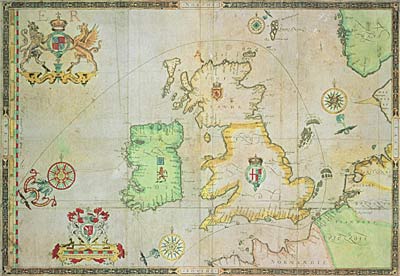 Philip decided to invade England. He planned to gather an army in the Netherlands. Then a huge armada (fleet) of ships would take the army across to England.
Philip decided to invade England. He planned to gather an army in the Netherlands. Then a huge armada (fleet) of ships would take the army across to England.
In February 1588, Philip's commander in the Netherlands reported that an army of thirty thousand men was ready.
In May 1588, an 'Invincible Armada' of 130 ships set sail from Lisbon in Portugal.
After you have studied this webpage, answer the question sheet by clicking on the 'Time to Work' icon at the top of the page.
Links:
The following websites will help you research further:
The Armada:
•
Three Ballads by Thomas Deloney, who was a 16th century English writer (shows how the English felt about the defeat of the Armada).
The Story of the Armada
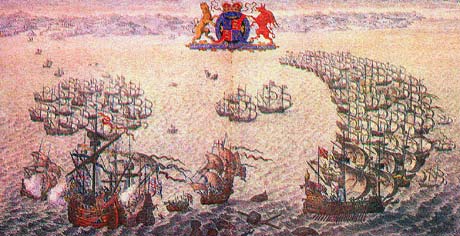 1
19 July – The English Channel: The Armada reached the English Channel. It took up a defensive crescent (half-moon) formation. The English fleet chased it. There was a series of battles, but only three Spanish ships were lost.
1
19 July – The English Channel: The Armada reached the English Channel. It took up a defensive crescent (half-moon) formation. The English fleet chased it. There was a series of battles, but only three Spanish ships were lost.
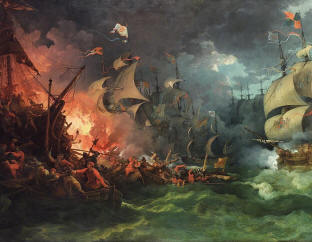 2
27 July – Calais : The Spanish fleet anchored near Calais, but Philip's troops were not ready. Next day, the English sent fireships into the Spanish fleet. The Spanish ships cut their anchors and fled out to sea. In the panic, one ship crashed into another and ran aground.
2
27 July – Calais : The Spanish fleet anchored near Calais, but Philip's troops were not ready. Next day, the English sent fireships into the Spanish fleet. The Spanish ships cut their anchors and fled out to sea. In the panic, one ship crashed into another and ran aground.
3 29 July – Battle of Gravelines: The Spanish were no longer in formation. They sailed into the North Sea.
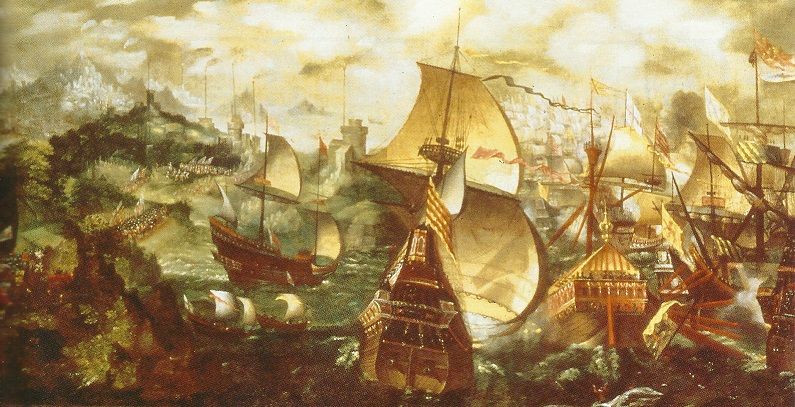
The English ships attacked them for six days. The Spanish sailors fought bravely. Four Spanish ships were lost, but many others were badly damaged. English warships were longer and narrower than the Spanish galleons. They could turn more quickly than the Spanish ships, especially in bad weather. Also, the gun-ports were larger than on Spanish ships, so the gunners could see where they were firing.
 4
7 August – The Great Gale: The Spanish ships tried to make their way home round the north of Scotland. They had little food or ammunition left; many sailors died of starvation. Storms separated the Spanish fleet. It is thought that 35 Spanish ships were lost.
4
7 August – The Great Gale: The Spanish ships tried to make their way home round the north of Scotland. They had little food or ammunition left; many sailors died of starvation. Storms separated the Spanish fleet. It is thought that 35 Spanish ships were lost.
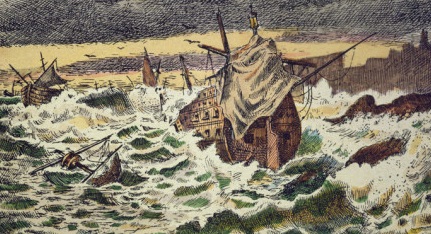 5
Late August – Ireland: At least 20 ships were wrecked on the coast of Ireland. Spanish sailors who managed to get ashore were put to death by the English soldiers in Ireland. During September, 67 damaged ships limped back to Spain. The invasion had failed.
5
Late August – Ireland: At least 20 ships were wrecked on the coast of Ireland. Spanish sailors who managed to get ashore were put to death by the English soldiers in Ireland. During September, 67 damaged ships limped back to Spain. The invasion had failed.